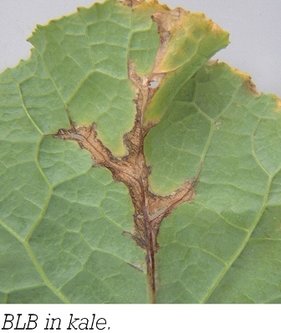Bacterial leaf spot and black rot
Two common bacterial leaf diseases in brassicas are bacterial leaf spot (Pseudomonas syringae pv. maculicola) and black rot (Xanthomonas campestris pv. campestris). Both affect a range of brassica crops. Pseudomonas syringae is primarily a leaf pathogen whereas Xanthomonas campestris systemically infects the plant.
Identification
Pseudomonas syringae pv. maculicola is typically seen as light brown-black spots with narrow to wide yellow halos. Xanthomonas campestris pv. campestris causes V-shaped lesions on the leaf edge where the veins turn black. Black internal stem staining also occurs. Infected leaves become yellow and die prematurely

Importance
Damage to leaves can be severe and result in reduced feed quality and quantity.
Spread
Both these bacterial pathogens can survive on crop debris in the soil and can be seed-borne. In addition, Pseudomonas syringae pv. maculicola can also survive on weeds. Warm, wet, windy conditions help disperse spores, which enter the host tissue through wounds or natural openings.
Prevention and management
Sow machine cleaned and certified seed to minimise infection, and allow at least a 3-year rotation following an outbreak using non-host crops like ryegrass.

